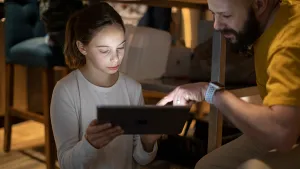Rethinking screen time: is tech really the problem?
Look past the headlines to see what screen time means for students.
Earlier this month, the American Heart Association (AHA) released a study titled "Screen Time Is Associated With Cardiometabolic and Cardiovascular Disease Risk in Childhood and Adolescence."
The results appear alarming: In the study, each hour of screen time was associated with higher cardiometabolic risk in both children and adolescents. For those whose sleep was negatively affected by screen time, this increased the risk per hour— by quite a bit.
"It’s a small change per hour," said the author of the study David Horner, M.D., PhD in an American Heart Association press release, "but when screen time accumulates to three, five or even six hours a day, as we saw in many adolescents, that adds up. Multiply that across a whole population of children," he added, "and you’re looking at a meaningful shift in early cardiometabolic risk that could carry into adulthood."
Screen time: evil or menace?
I am a child of the 70s: the first generation that was going to be absolutely ruined by screen time (first TV, which would "rot our minds," and then in the 80s gaming, which would "make us violent").
My mother was absolutely unbending on the issue; we couldn't watch TV. Except for PBS, as a family once a week. Only wholesome family entertainment like animals violently killing and eating each other on Marty Stouffer's "Wild America."
After several decades of informal data collection, it's clear that my brain rot and violent tendencies seem to be about the same level as the friends of mine who watched hour after hour of TV and video games in the 70s and 80s.
Cool story, bro. But what's the hard data on screen time?
The hard data on screen time is this: it's really, really complicated.
News outlets and high-profile organizations do not like this answer. It is smooshy. It does not make for compelling headlines.
In Behavioral Scientist's 2018 article "A History of Panic Over Entertainment Technology," Authors Christopher J. Ferguson and Cathy Faye discuss decades of research on the how technology affects people and compare the research with official statements, recommendations and public assumptions regarding electronic media.
How we understand these studies
Unfortunately, news outlets often simplify, gloss over or just plain report results incorrectly.
(Anecdotally, a big part of my job is finding studies on tech. Many time- and staff-strapped organizations will simply copy headlines and conclusions from the AP or from each other. I track down the actual studies themselves, and the number of studies that came to the opposite conclusion to what headlines report is disturbing.)
In addition, say Ferguson and Faye, organizations that should know better (The US Surgeon General's Office, well-respected physician groups) often issue statements, advice and even policies based on these oversimplifications or misreadings.
Are schools too dependent on technology?
Parents, like myself, are often busy and stressed. We see the headlines and we, well. I'll admit it. Sometimes we panic.
We monitor screen time at home, which is perfectly acceptable, and in some cases, ban it outright from our homes. And sometimes, we run to our kids' schools to demand that they stop using devices like iPads in the classrooms. After all, the AHA study seems pretty darn definitive.
What the study actually says
The American Heart Association study pulls from parental reporting of "time spent watching TV, movies, gaming or using phones, tablets or computers for leisure." (Note the lack of information about time spent on screens at school; this would have been a logistical nightmare, but the fact remains that a large portion of children's days are not accounted for in the study.)
There were two cohorts: 18-year-olds in 2000 and 10-year-olds in 2010. Adjusted for sex and age, the study seems cut and dry: more screen time is bad for children's and adolescents' hearts. It even breaks down exactly how much heart risk rises per hour and uses well-accepted metrics of cardiovascular risk to determine this:
- Waist size
- Blood pressure
- High-density lipoprotein or HDL “good” cholesterol
- Triglycerides
- Blood sugar levels
More hours = more heart risk. Fewer hours = less heart risk. Lack of sleep makes it all worse. (The latter is well-documented basically everywhere.)
Yes or no. Black or white.
Except for one thing.
A flaw in the study
Although the researchers adjusted for gender, age and amounts of sedentary time each cohort had in relation to the other cohort, they didn't have a control group that spent the same amount of time being sedentary while they did other things: read, for example, or craft, or knit or the myriad of other things that also require a person to remain still most of the time.
And that's a big, big flaw.
If there's anything definitive in our understanding of our complex bodies, it's that lack of movement can cause all kinds of health problems as we age, affecting the heart, joints, blood pressure, and HDL cholesterol.
But without a control group of students who don't get screen time but who spent a similar amount of time being sedentary, it's very hard to link the screens, instead of the stillness, to the problem.
So before we go for screens in schools, we need to remember something: most students already must remain sedentary for many, many hours when they're at school.
Sedentary time at school, regardless of devices
Studies have shown that in the U.S., K-12 students spend roughly 63% of their time in school sedentary.
A global survey of similar studies found that students are sedentary for most of the school day — which is often most of the full day — around the world.
What's the difference between active vs. passive screentime?
So, it might not be about the screens themselves. It might depend more on what the youth are doing on those devices. Are they excited and engaged in learning? Are they able to easily share their work with others and collaborate on exploring questions that interest them?
And it might depend a lot on where they are using the devices. Are they moving around the classroom as they use them? Bringing them outside to have an impromptu outdoor lesson? Are they using them to interface with interactive learning tools?
What are the benefits of educational screentime?
If we want our kids to be healthier, it might make more sense to tackle the "sitting still all the time" problem.
While most schools globally require students to spend the majority of their time sedentary in school, several pedagogical approaches to teaching increase movement.
And many of them depend on the useful application of tech.
Technology-Enabled Active Learning (TEAL)
Originated at MIT for university students as a way to enact student-centered learning and modified for high schools and primary schools, TEAL classes feature:
- Collaborative, small-group learning at different places in the classroom
- Media-rich visualizations and simulations to help students better understand (and interact with) STEM concepts
- Personal response systems that allow students closer communication with lecturers and instructors
When properly implemented, TEAL classrooms involve constant movement: students interact with manipulatives and concepts, move from one part of the classroom to the other and become genuinely immersed in their education.
Student-centered learning
Student-centered learning is a learning methodology that allows students to engage in decisions about what they learn and how they learn it.
- Student-centered learning encourages physical movement with:
- Project-based learning (learning by doing)
- Inquiry-based learning: (exploring how to find the answer to a question they care about)
- Collaborative learning: (group work fostering engagement and deeper understanding)
It's possible to engage in student-centered learning without the use of screens. But it's much, much easier to implement with access to the internet, to library catalogues, and to classroom materials — regardless of where the students are learning.
Experiential learning models
This teaching philosophy engages students directly in the world of work or other hands-on activities, followed by focused reflection. This is meant to solidify student understanding and learning not only the material but also their relationship to the material.
This can include field trips to workplaces or natural places, hands-on activities with environmental educators, place-based education and expeditionary learning.
You'd think that this sort of learning model would be antithetical to screen time.
But you'd be wrong.
School tech that incorporates musical instruction, robotics and research into this hands-on model can experience more success. During reflection times, students who have electronic access to school resources that encourage writing and research on-site have chances to engage in this reflection on the spot and while their brains are still focused on the experience.
The real threat to our children's health: sedentary time.
If you're worried about screen time at your kids' schools, I encourage you to pivot your focus to movement. Visit the classroom, ask questions about how teachers use technology aids in and outside of the classroom, and observe how much students move around in class— regardless of screen time.
I also encourage parents like me to go find the actual studies, and to understand them in context with other studies on the topic. Take a closer look at the methodology of studies. Look for what's missing and what innate assumptions researchers might be unaware they are making.
We all want bright, thriving and healthy kids
This isn't to say that those who author studies like this or perform research looking into these questions are somehow lazy or malevolent. For this study in particular, I'm not sure where anyone would have been able to find a control group of youth with comparable sedentary time to both cohorts who also didn't use screens. And most of this is necessary, important research.
Researchers who study these issues want to help kids.
And much of what the study says is useful and immediately applicable: regardless of why kids are sedentary, limiting screen time at home is probably a good idea if only to reduce sedentary time (and how bright screens affect sleep!).
I'm just saying: go beyond the headlines. Ask your kids what they're up to at home and at school. Read up.
Because better understanding can lead to better outcomes.


